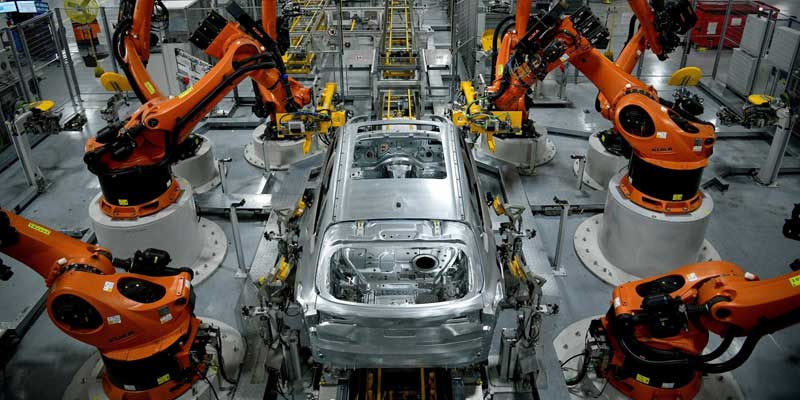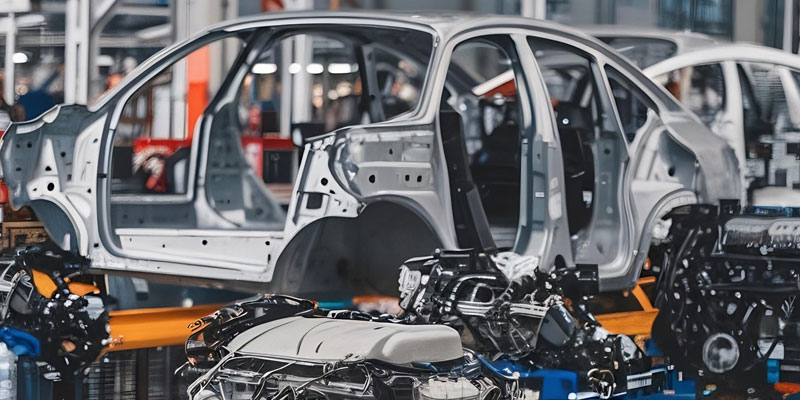Schedule a Call Back
How to build India’s global manufacturing capabilities?
 Articles
Articles- Jun 28,24

The Government of India (GoI) has been aiming to increase the contribution of manufacturing to total GDP from around 15-17 per cent to 25 per cent for the last many years. To achieve it, GoI has rolled out various initiatives like Aatmanirbhar Bharat/Make in India, Production-linked Incentives (PLI) scheme, low corporate tax rates for new manufacturing units, etc. It has been also spending on improving infrastructure and the logistics network via Gati Shakti mission, multi-modal connectivity, etc. Despite efforts, manufacturing’s share in the economy has not significantly increased and more efforts are required to propel its growth.
“It is crucial to integrate local resources while maintaining a global outlook to achieve success with value-based products. Regarding the efforts made by governments over the past decade to boost the manufacturing sector's contribution to GDP, it's evident that despite these efforts, the manufacturing share has remained stagnant to around 17 per cent,” highlights Manish Jhunjhunwala, Executive Director, PwC India.
India is experiencing significant development and opportunities fuelled by government spending in infrastructure and related sectors. This move has spurred demand in the manufacturing sector - especially automotive, construction equipment, agriculture equipment, and material handling. Sandeep Khullar, Director of Off-Highway and Commercial Vehicle, Dana India, elaborates, “In the tier one auto component manufacturing sector, there is significant excitement and opportunity driven by government infrastructure investments. This creates a strong demand in automotive, construction equipment, agriculture, and material handling. The growth of e-commerce is also increasing the need for material handling solutions. Global customers are turning to India as a strategic partner, attracted by competitive pricing and the ability to meet global quality and delivery standards. Many OEMs are diversifying their supply chains away from China due to geopolitical factors, further benefiting India. India is emerging as both a manufacturing and sourcing hub to support global operations. This shift presents significant opportunities for the sector. The key challenge now is to effectively capitalise on this strong local and global demand.”
Increasing India’s global share
Sharing his perspective on the prevailing market scenario, Dr Jairam Varadaraj, Managing Director, Elgi Equipments Ltd, opines, “Protectionism is rising globally, driven by right-wing political platforms in developed countries seeking to safeguard their economies. Bilateral treaties are becoming more common as countries move away from multilateral agreements. India, with its strong international presence, is well-positioned to negotiate favourable treaties, so protectionism is not a major concern for Indian companies looking to access global opportunities.”
However, he believes that the challenge lies within. “India's tendency has been to produce low-cost products for the bottom of the market pyramid. Globally, 80 per cent of opportunities are in high-performance, value-based buying, not price-based. Focusing on low-cost segments means limiting growth and keeping wages low, which isn't beneficial for India. To capitalise on global opportunities, India must invest in technology, quality, and advanced systems and processes. This requires a long-term approach, but with commitment, the opportunities are substantial,” elaborates Dr Varadaraj.
According to T K Ramesh, Managing Director, Ace Designers Ltd, the market conditions for Indian manufacturing are both exciting and challenging. “The excitement stems from the potential for growth and the opportunities presented by the evolving global economic landscape. However, these opportunities come with challenges that require manufacturers to be agile and adaptable,” he adds.
The ability to predict long-term trends has diminished (because of the high volatility and uncertainty in the market), making it essential to plan for shorter terms. Ramesh explains, “Long-term plans of five years have now become two or three years. Strategic plans require agility, the ability to fail quickly and cheaply, and rapid retooling to stay competitive. The market is growing and becoming more competitive. Success hinges on adaptability and delivering better value to the marketplace.”
On the export front, Indian manufacturers face both opportunities and competition. He says, “Geopolitical shifts particularly trade tensions between the US and China, have prompted global companies to diversify their supply chains. This shift opens doors for Indian manufacturers to become strategic partners. However, India must compete with other emerging economies like Vietnam and Thailand, which are also vying for a share of the global manufacturing pie.”
Changing industrial space
Manufacturing landscape has also undergone a sea change in the last decade with industrial revolution and modern technologies. R Jayaraman, Head, Capstone Projects, Bhavan's S P Jain Institute of Management & Research (SPJIMR), elaborates, “India's participation in industrial revolutions increased significantly during the third age, where it found its niche in information technology. India's strength in this field is unmatched globally. Recent years have seen significant developments, especially since the current government took power in 2014, driving momentum in various sectors. India is currently in the fourth age, Industry 4.0, following the third age of computers. Industry 5.0, a new concept from Japan called ‘human plus’ that emphasises the importance of human beings in the Internet of Things (IoT) development.”
The last couple of years have been full of ups and downs for industries globally. Hence, Indian manufacturers are facing several challenges today. “First, capital investment is crucial. While the government has made substantial investments in infrastructure and the defense sector, private industry also needs to contribute. This is vital as Foreign Direct Investment (FDI) fell by 43 per cent from $80 billion in 2022 to $46 billion in 2023 and is expected to decline further in 2024. Second, there is a need for skill development, particularly in artificial intelligence (AI), machine learning (ML), and algorithm development. While there are new-age companies that are taking efforts, more needs to be done, especially in engineering colleges and professional bodies,” he says.
For manufacturing to thrive, it is important for the companies to raise remuneration for the employees. Jayaraman says, “Appropriate compensation must be addressed. Indian salaries are low compared to international markets, leading to dissatisfaction among graduates. Recently, almost 30 per cent of IIT graduates remained unplaced, partly due to salary expectations.”
According to him, these challenges—capital investment, skill development, and appropriate compensation—need urgent attention for India to move forward.
Capitalising on global drivers
A strong, growing domestic market and favourable government policies (at the center as well as state level) have prompted global firms to look at India favourably. As a result, in the last few years, many multinational companies (MNCs) have increased their manufactuirng footprint in India to meet their global requirements.
Elaborating on the key yardsticks used by MNCs while investing in a country, Sandeep Khullar says, “When making investment decisions, global companies consider several key factors. The presence of a substantial domestic market and long-term business potential is crucial. A country must offer significant domestic industry and consumer opportunities. Consistent government policies, favourable tax structures, and a business-friendly environment are vital for decision-making. Adequate infrastructure for manufacturing and a robust logistics network for exports are essential, especially for companies relying heavily on exporting goods. Availability of skilled labour in manufacturing and other functions is a significant consideration. A strong domestic supplier base for materials and components is necessary since not everything can be manufactured in-house. The country must be competitive compared to other investment options globally. India scores favourably on most of these parameters, making it an attractive destination for global investments.”
China-Plus-One policy and relatively high national GDP growth rate present a big opportunity for India to emerge as a manufacturing hub for the world. Ramesh explains, “The US-China trade tensions have prompted many global companies to adopt a China-Plus-One strategy, diversifying their supply chains by adding manufacturing bases outside China. This presents a significant opportunity for India to position itself as a preferred manufacturing destination. However, seizing this opportunity requires substantial improvements in infrastructure, technology, and human capital.”
But, India faces competition from countries like Vietnam, Indonesia, Malaysia, and Thailand, which are often better prepared in terms of infrastructure and company readiness. Despite this, he believes, the presence of major automotive giants and their established supply chains in India offers a foundation for scaling up and adopting newer technologies.
India is currently at a nascent stage in adding value through technology arbitrage. “To catch up, improvements must go beyond material and labour arbitrage, focusing instead on advancing processes, science, and scale. The country's large domestic market, favourable demographics, and strategic location are attractive to global investors. Additionally, India's commitment to reforms and ease of doing business enhances its appeal,” observes Ramesh.
However, to compete effectively with other emerging economies, India must continuously improve its manufacturing ecosystem. He adds, “This includes making timely investments, acting swiftly, and effectively leveraging its abundant human capital, which remains a significant challenge.”
Impact of government initiatives
The Government of India, as part of its Aatmanirbhar Bharat initiative, announced Production-Linked Incentive (PLI) schemes for 14 sectors in 2021 with an outlay of Rs 1.97 lakh crore to attract big investments in manufacturing and build capacity. “There is a lot of buzz around manufacturing being strengthened and brought to the forefront. The PLI schemes aim to introduce technologies that were not present previously in India, particularly for electronic and chip manufacturing. This has started to show results, although the full benefits are expected in the long term,” states Ramesh.
The PLI schemes offer financial incentives to manufacturers based on their production output. These schemes target specific sectors, including electronics, pharmaceuticals, and automotive, to boost domestic manufacturing capabilities. The initial response to the PLI schemes has been positive, with several companies committing to substantial investments. “The impact of these initiatives is expected to be significant in the long term. As manufacturers benefit from incentives and support, they are likely to invest in upgrading their facilities, adopting new technologies, and improving productivity. Over time, this will enhance the competitiveness of Indian manufacturing and contribute to higher GDP growth,” elaborates Jayaraman.
However, it is still a long way to making India a manufacturing powerhouse of the world. Ramesh adds, “Currently, manufacturing contributes about 15-17 per cent to GDP. Doubling this to about 30 per cent will require more efforts. The shift from IT to manufacturing involves significant changes in materials, technology, and processes. India is recognised globally for its talent in IT, healthcare, and engineering, but building a strong product manufacturing base will take time.”
According to Manish Jhunjhunwala, India has a large youth workforce, which is a key strength. “However, the availability of skilled manpower is uneven across sectors and regions. Addressing the skill gap through targeted training programs and partnerships with educational institutions is essential to meet the demands of advanced manufacturing. India's overall competitiveness is influenced by factors like cost of production, innovation capability, and business environment. The country's competitive advantage lies in its cost-effectiveness, but to sustain this advantage, continuous improvements in productivity, innovation, and quality are necessary,” he explains.
Despite challenges, Ramesh believes India’s foundation is strong. He adds, “The aerospace sector and multinational research centres in India are good examples of progress. To advance further, it is crucial to make manufacturing more attractive and respected. This involves celebrating manufacturing successes and drawing more youth into the field, with support from the government and industry.”
Have a global outlook
Government policies and initiatives play a crucial role in enhancing the competitiveness of the manufacturing sector. Recent investments in infrastructure have improved the logistics and transportation network, making it easier for manufacturers to move raw materials and finished goods. The development of industrial corridors, dedicated freight corridors, and smart cities has created a more conducive environment for manufacturing operations. The emphasis on ease of doing business, labour reforms, and skill development is creating a more supportive environment for manufacturers. Additionally, financial incentives and support programs are encouraging investments in advanced manufacturing technologies.
However, for India to make a mark on the international market, individual companies will have to play a big role by increasing their global competitiveness. “It is the individual players (citizens, companies, organisations, etc) who are the key drivers of the economy, while the government plays the role of a facilitator. Hence, it is important for every individual to aspire to be global for India to be a globally competitive country. International market offers huge opportunity in terms of exponential growth for companies. To tap this opportunity, it is crucial for the company to transform at every level (such as processes, workforce, products, etc) with a global outlook and strategy. It is a long drawn process, but worth the effort as being globally competitive opens up new business opportunities,” opines Dr Varadaraj.
According to Jayaraman, the overall business environment in India is becoming more favourable for manufacturers. “Improvements in regulatory frameworks, tax policies, and dispute resolution mechanisms are reducing the cost and complexity of doing business. These changes are making India a more attractive destination for both domestic and global manufacturers,” he adds.
Plentiful of opportunities
The Indian manufacturing sector stands at a critical juncture, with several opportunities arising from global shifts and local initiatives. Challenges of capital investment, skill development, and infrastructure enhancement must be addressed to sustain balance. Despite competition from other emerging economies, India's advantages, including a large consumer market and favourable demographics, increase its attractiveness to global investors. Efforts across government, industry, and educational institutions can leverage India’s strengths to achieve sustainable growth and assert its position on the global manufacturing map.
(With inputs from Sanskriti Ramachandran)
This article is based on the webinar - titled “Can India Build Global Manufacturing Capabilities?” - organised by Smart Manufacturing & Enterprises on June 21, 2024
Dr Jairam Varadaraj, MD, Elgi Equipments Ltd
Protectionism is rising globally. India, with its strong international presence, is well-positioned to negotiate favourable treaties. So, protectionism is not a major concern for Indian companies looking to access global opportunities.
Sandeep Khullar, Director - Off-Highway and Commercial Vehicle, Dana India
India is emerging as both a manufacturing and sourcing hub to support global operations. This shift presents significant opportunities for the sector. The key challenge now is to effectively capitalise on this strong local and global demand.
T K Ramesh, MD, Ace Designers Ltd
India's large domestic market, favourable demographics, and strategic location are attractive to global investors. Additionally, the country's commitment to reforms and ease of doing business enhances its appeal.
R Jayaraman, Head, Capstone Projects, S P Jain Institute of Management & Research
The impact of PLI scheme is expected to be significant in the long term. As manufacturers benefit from incentives and support, they are likely to invest in upgrading their facilities, adopting new technologies, and improving productivity.
Manish Jhunjhunwala, Executive Director, PwC India
The availability of skilled manpower is uneven across sectors and regions. Addressing the skill gap through targeted training programs is essential to meet the demands of advanced manufacturing.
Related Stories

IESA to Launch Vision 2047 Battery Roadmap at IBMSCS 2026
IESA will unveil its Vision 2047 white paper at IBMSCS 2026 in Hyderabad, outlining a strategic roadmap to build a competitive, self-reliant domestic battery ecosystem for India.
Read more
Rewarding Manufacturing Resilience
Effective January 1, 2026, Mexico imposed import duties ranging from 5 per cent to 50 per cent on a broad set of goods from non-free trade agreement (FTA) countries, including India, China, South Ko..
Read more
EV transition and tariff wars redefine India’s auto components play
India’s auto component industry is poised to hit $ 145 billion by FY30 from $ 80 billion in FY25. Yet high US tariff, EV transition and heavy reliance on imports from China expose vulnerabilities,..
Read more














